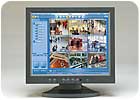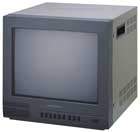
Dual looping composite video and audio inputs along with analog VGA/digital DVI inputs are available with this 19-inch LCD monitor from Bosch Security Systems Inc., Fairport, N.Y.
Security video monitors are more than just computer monitors. They have unique features that are pivotal to their successful use in security installations. Just picking up an inexpensive monitor from the local computer store will limit the choice of connections and options available and also limit its performance in the control room.
Monitors built for security video should have a VGA input, recommends Mike Capulli, senior vice president of sales for North America for GVI Security Inc./Samsung Electronics, Carrollton, Texas.
“If you’re buying a high-resolution camera with 520 lines of resolution or above but using a monitor designed for a computer that has 300 lines of resolution, you’ve wasted the money on the monitor,” Capulli points out.
VGA inputs are necessary to obtain full resolution from DVRs that use the VGA output, Capulli declares. He advises installing monitors with VGA and BNC inputs. BNC inputs are used direct from analog cameras and DVRs. They can run from 300 feet to 400 feet, which are longer than VGA outputs.
Video surveillance monitors often run 24 hours a day, so their design and component selection should allow for excellent cooling and low radiation, advises Cheryl Bard, product marketing manager for CCTV cameras, housings, monitors and hardware for Bosch Security Systems Inc., Fairport, N.Y.
She also emphasizes that to avoid electromagnetic interference from one monitor to another when they are mounted side-by-side, monitor housings must contain all electromagnetic radiation.
Capulli thinks tempered glass is necessary on the screen. “Because they’re in a high use area, [tempered glass] is more durable from an environmental standpoint,” he notes.
The use of tempered glass depends on where a monitor is going to be placed, thinks Adrian Parvulescu, national engineering manager for security products at JVC Professional Products Co., Wayne, N.J.
“Sometimes a monitor can be used as a deterrent, when, for instance, you put one outside the entrance to a store and let people know by showing their images as they step into the facility that they are under surveillance,” Parvulescu describes. “Those monitors should be protected a little bit against vandalism. They should probably be built into a steel-type case with shock-resistant front glass.”
Capulli also suggests audio inputs, contrast ratios of 750:1 and above and resolutions of 1,280 by 1,024 pixels. Reaction speeds should be 5 milliseconds to avoid latency or time delay in the video.
Bard recommends that monitors have standard VESA mounting that includes hole patterns for wall and other types of mounting besides just being on a stand.

A horizontal resolution of 500 TV lines is provided by this 21-inch flat-screen color CRT monitor from GVI Security Inc./Samsung Electronics, Carrollton, Texas.
CRTS STILL THE NORM?
A whole host of new technologies — liquid crystal displays (LCDs) and plasma flat screens in ever-larger sizes, front and rear projectors for even larger, room-size displays, and the preference of some software systems for a single graphical user interface (GUI) — are all resulting in more choices and versatility than ever before.Cathode ray tubes (CRTs) typically provide a higher resolution and a better viewing angle than LCDs, Bard notes, although LCDs require less space and power.
“The CRT is not on its way out — it’s cost-effective technology, and because of its price, it still sells quite significantly,” Capulli maintains. But Parvulescu points out that the law of supply and demand is affecting CRT prices.
“It’s funny because right now, the price for the CRT started going up a little bit, because the manufacturers do not manufacture as many as before, while the LCD display prices are going down, because the demand is so great,” Parvulescu reports.
Capulli thinks CRTs have always had better picture quality than flat panel monitors, but now thinks LCD panels are improving. “With higher contrast ratios, they are catching up, and some are equal to CRT technology,” Capulli maintains.
The most popular sizes for security monitors nowadays are 17-in. to 19-in. flat-panel LCD displays, with 32-in. and 42-in. monitors becoming popular for public viewing, Capulli reports.
Bard points out that 19 inches is typically the largest size that will fit into an equipment rack.

Sidebar: The Big Screen
For viewing in large rooms, such as airport control rooms or stock exchanges, big-screen options are becoming available and affordable, although most are not made specially for the security market but adapted from their original uses.Because larger screen sizes can display multiple images, large monitors also can be used to reduce the number of monitors required, points out Cheryl Bard, product marketing manager for CCTV cameras, housings, monitors and hardware for Bosch Security Systems Inc., Fairport, N.Y.
“As you start to cram more information on the screen, you reach a point at which you have to increase the monitor size,” notes Adrian Parvulescu, national engineering manager for security products at JVC Professional Products Co., Wayne, N.J. “That’s up to the system what exactly they want to display at the same time.”
Do plasma or LCD flat screens have better quality? “In the beginning, plasma was like the real darling of the industry, because the quality was there and the LCD was not up to speed, but in the past few years, the LCD improved a lot,” relates Parvulescu. “Consequently, I think the plasma is going down right now.
“Plasma has a problem with heat dissipation, which is not present in LCD monitors, and the improvement in LCD quality is tremendous, to the point that I wouldn’t challenge a plasma monitor with an LCD, because an LCD is going to win,” he insists. “You’re still going to see some plasma panels in big security rooms, but I bet you anything those rooms were designed and implemented a few years ago.”
Plasma monitors feature better image quality, Bard thinks, but they do not last as long as LCDs and risk burn-in of stationary images, which can be prevalent in surveillance video.
For really big displays, rear or front projectors can be more cost-effective than flat panels. “If you’re talking about a big control room and you want to have a big display to display images from tens of cameras, probably the best way to do it is to have a rear or front projector,” Parvulescu recommends. “The resolution will be there and also the size.”
Front projectors do not have the limited angles of view that rear projection screens do, but they require a darkened room. The contrast ratio and brightness of front projectors may be a little lower, but a good screen can help that.
“If you get one of the latest front projectors, they can be extremely bright with a huge contrast ratio, and then the screen really doesn’t play as big a role,” he points out.
Sidebar: Upconverting CCTV to LCDs Is Expensive
When using flat-screen LCD panels with analog video cameras, matching the screen resolution to that of the camera is important, insists Adrian Parvulescu, national engineering manager for security products at JVC Professional Products Co., Wayne, N.J.“The current LCD technology is not capable of reproducing very well a signal coming from an analog camera, like a CCTV camera, unless they are built with a flat panel which has a native resolution equal or very close to the CCTV camera,” he maintains.
This is a phenomenon seen with LCD monitors in which a high-resolution LCD monitor displays a lower resolution analog image worse than it looks on a lower-resolution CRT. The reason is that the monitor has no instructions on how to distribute the lower number of pixels of the analog image over the higher resolution.
The native resolution coming from an analog video camera will probably be approximately 640 by 480 pixels, whereas an LCD monitor that was originally designed for computer applications will have a resolution of 1,024 by 768 pixels.
Upconverting the camera’s signal can improve quality, but it does so at a high price, Parvulescu asserts. Building LCD monitors with native resolutions of 640 by 480 also is expensive. “That is one of the reasons a CRT monitor for cheap security applications is probably still in use,” he thinks.
“It’s kind of difficult to imagine what I said, but trust me, when you see an excellent resolution monitor used with a CCTV camera, you’ll see a very good picture, but the price tag will not make it usable in the CCTV market,” he stresses. “You’re looking at a $2,000 monitor, and nobody is paying that price in a security application.
“With security applications, the trend is very price-sensitive, and the quality will come second,” he insists. “That’s the market, unfortunately.”


